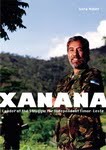Bonoite no Kalan kmanek. Ohin kalan ita mai atu hasoru malu no rekonyese esforsu ida bot katak hau nia maluk ida, Sara Niner, realiza ona atu hakerek historia ida importante tebetebes kona ba ita nia rai no ita nia ema nia historia. Historia kona ba ema ida, mane ida, nebe ita hotu konyese no ita hotu hanoin ita konyese: ohin loron, ita nia Primeiru Ministru, Sr. Xanana Gusmao.
Tanba Sara ema ida husi rai seluk, no ema ida ne’ebe koalia liafuan ingles, hau husu ita bot sira nia permisaun atu koalia iha liafuan ingles.
Good evening, and welcome.
Permit me all the indulgence to recount my own little short story. Growing up in suburban Melbourne in the 1980s and 90s was about as far removed as you could get from the realities of life in Timor between the period of 1975 and 1999: far removed from hiding up in Mount Ramelau, holed up in a cave in Bauro or conducting clandestine meetings in Dili.
But the solidarity always existed. Whether you were a Timor oan or a malae. From East Timor solidarity groups in Melbourne to New York, Lisbon and many other cities around the globe, we were one in our shared commitment and determination for the realization of self-determination of the Timorese people.
It was in this context that Sara Niner and I first crossed paths in 1993. In working together on a project to learn from the experiences of one of the leaders of the Eritrean People’s Liberation Front to organizing fund-raising Aussie Rules Football matches for the cause, an incredibly strong friendship was being formed as a by-product of our mutual activism, deep respect for the figures of the liberation and for Xanana Gusmao. We demonstrated when Xanana was captured and we cried together when he gave an impassioned speech over a loudspeaker transmitted at the top of Bourke Street at the steps of Parliament house in Melbourne in 1999. Little belief and sense did I have at the time whilst demonstrating up and down the main streets in Melbourne, that Timor would be where it is today, and that we would be standing here Sara.
Timor, its people and Xanana existed in another dimension: on banners, photographs, t-shirts and postcards. I first met Xanana on the front of a tshirt, Sara met him in Salemba, Jakarta, under house arrest in 1998. He was then, as is the case now, the voice and aspirations of our people.
Xanana once said, “it was not Xanana, it was the people”, and it is on the pages of this biography that those stories are also revealed.
The product of 12 years of scholarly study interspersed with having a child, working and finally completing a thesis have resulted in a work of great depth, understanding and clarity. The commitment and vision to distil 100,000 words of a thesis into a coherent, engaging and insightful account of ‘Xanana, Leader of the Struggle for Independent Timor-Leste’ is nothing short of a remarkable effort.
It is the journey not only of a remarkable man, but also of a remarkable people and land and the events that have shaped all of our lives.
Sara Niner has dedicated the biography to “all the veterans and those who suffered during the struggle for independent Timor-Leste: women and men; young and old”.
Her gift is to us all, and especially to Timorese, of all ages, for the ages: I grew up getting to know my people and my homeland a little better by reading the stories written by close family friends and authors in Melbourne, Cliff Morris, Michelle Turner and others,
So let me take this (public) opportunity to express my deepest gratitude and sincerest admiration to Sara Niner for this enduring and invaluable gift of documenting and retelling such a large and important part of Timorese history through the story of Xanana.
And in closing, for her enduring friendship.
Parabens e Obrigado wa’in Sara.


